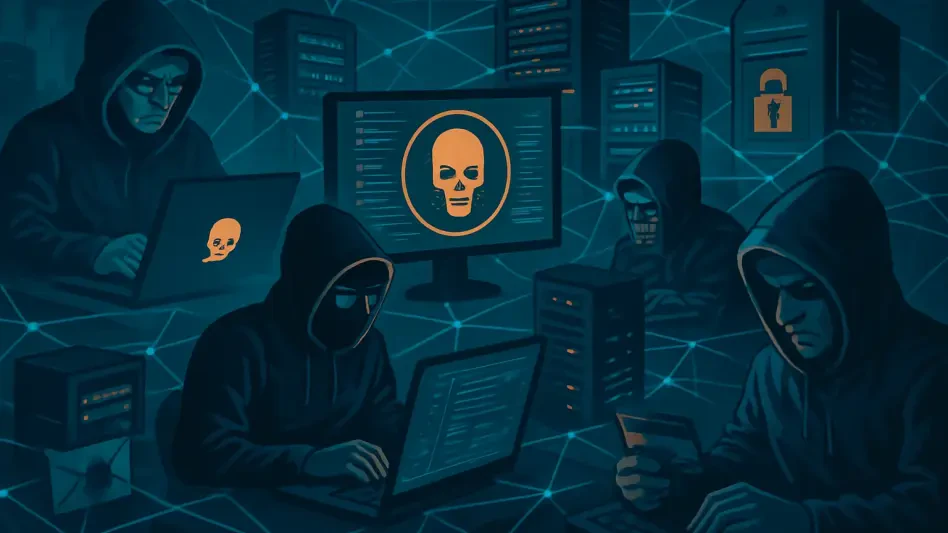In an era where digital connectivity underpins nearly every facet of modern life, the emergence of sophisticated cybercriminal networks poses an unprecedented threat to global security, and one such entity, known simply as The COM, has rapidly ascended from obscure online forums to a sprawling, decentralized ecosystem orchestrating some of the most damaging cyberattacks worldwide. This English-speaking network has evolved over more than a decade, transitioning from petty online schemes to a professional criminal economy targeting everything from multinational corporations to critical infrastructure. Its rise reflects not just technological prowess but a chilling ability to exploit human vulnerabilities at scale. As organizations and governments grapple with the fallout of data breaches, ransomware, and financial fraud, understanding the inner workings of The COM becomes paramount. This exploration delves into the origins, operations, and enduring resilience of a shadowy force that continues to redefine the landscape of cybercrime with alarming precision.
Roots of a Digital Underworld
The journey of The COM began in the shadowy corners of the internet during the early to mid-2010s, where English-speaking cybercriminals congregated on platforms like RaidForums and OGUsers to trade coveted social media handles dubbed “OG” for original gangster. These early interactions were less about financial gain and more about building street cred among peers through social engineering and manipulation. Such tactics laid the groundwork for what would become a hallmark of The COM’s approach. A pivotal moment came when law enforcement interventions disrupted these initial hubs, triggering a phenomenon known as the Migration Effect. This forced a blending of social engineering expertise with the technical skills of breach-focused hackers, creating a hybrid breed of cybercriminals. No longer confined to niche activities, these actors began to orchestrate more ambitious and coordinated attacks, setting the stage for a criminal network that could challenge even the most fortified digital defenses with startling ingenuity.
This evolution marked a significant shift in the underground community, as The COM transformed from a loosely connected group of opportunists into a structured, reputation-driven entity. The fusion of diverse skill sets enabled the network to target a broader range of victims, from individual investors to large enterprises. Social engineering, once a tool for minor scams, became a weapon for infiltrating corporate systems by exploiting the human element—often the weakest link in security protocols. Meanwhile, the technical hackers brought sophisticated methods for breaching networks and extracting valuable data. This synergy not only amplified the scale of their operations but also attracted new talent eager to join a thriving criminal ecosystem. As a result, The COM quickly outgrew its origins, positioning itself as a formidable player in the global cybercrime arena, capable of adapting to challenges and exploiting emerging opportunities with ruthless efficiency.
A Sophisticated Criminal Economy
Today, The COM operates as a complex, multifaceted criminal economy, orchestrating a wide array of illicit activities that include large-scale data breaches, ransomware campaigns, extortion, SIM-swapping, cryptocurrency theft, and financial fraud. Key players within this network, such as Lapsus$, ShinyHunters, and Scattered Spider (UNC3944), function with specialized roles within hierarchical structures, each contributing to a well-oiled machine of cybercrime. These groups monetize their expertise through underground supply chains that streamline complex attacks, making them accessible even to less skilled entrants. This democratization of cybercrime tools has significantly expanded the network’s reach, enabling it to target a diverse array of sectors and geographies. The sheer scope of these operations underscores how The COM has industrialized crime, turning once-isolated hacks into systematic assaults on global digital infrastructure with devastating consequences.
Beyond the technical sophistication, The COM’s success hinges on its ability to exploit systemic vulnerabilities across industries. By lowering the barriers to entry, the network has created a thriving marketplace where tools, stolen data, and services are traded with alarming ease. This ecosystem not only sustains veteran cybercriminals but also nurtures a new generation of attackers eager to profit from digital misdeeds. High-profile incidents, often executed with audacious simplicity, reveal how groups within The COM can penetrate even well-guarded systems by leveraging insider access or stolen credentials. Such attacks frequently result in massive financial losses and reputational damage for victims, while the perpetrators remain elusive, hidden behind layers of encryption and anonymity. As this criminal economy grows, it poses a persistent challenge to cybersecurity professionals striving to protect sensitive data and maintain trust in an increasingly interconnected world.
Exploiting Human and Technical Weaknesses
At the heart of The COM’s effectiveness lies its mastery of social engineering, a tactic that preys on human vulnerabilities to bypass even the most robust technical defenses. Groups like Lapsus$ have perfected the art of manipulating employees, particularly IT staff, to gain unauthorized access to corporate networks. These incidents often start with a simple phone call or a crafted email, exploiting trust to extract sensitive information or credentials. Such strategies have led to high-profile breaches that demonstrate the potency of targeting the human element over complex code. This persistent focus on people as the entry point reveals a critical gap in organizational security, where even advanced systems can be undermined by a single lapse in judgment or awareness among staff members.
Compounding this issue are technical weaknesses that The COM exploits with precision, particularly in SMS-based multi-factor authentication (MFA). Through SIM-swapping techniques, pioneered in early forums, attackers can hijack phone numbers to intercept security codes, rendering accounts and cryptocurrency wallets vulnerable. This method has proven alarmingly effective, often leaving victims with little recourse once funds are drained or data is stolen. Addressing these flaws demands a shift toward phishing-resistant MFA solutions, such as FIDO2/WebAuthn, alongside rigorous identity verification processes. Organizations must also prioritize ongoing training and simulations to equip employees against deception tactics. Until these vulnerabilities are addressed, The COM will continue to capitalize on the intersection of human error and outdated security practices, perpetuating a cycle of breaches that erode confidence in digital systems.
Resilience Amidst Disruption
Unlike traditional cybercriminal models, The COM stands out for its remarkable resilience and decentralized structure, which have allowed it to withstand significant law enforcement efforts. Despite high-profile arrests and the takedown of key platforms like RaidForums, the network has not faltered. Instead, disruptions have spurred fragmentation, with threat actors scattering to encrypted platforms such as Telegram and Discord, as well as exclusive, invite-only channels. This adaptability complicates conventional monitoring and threat intelligence gathering, leaving authorities struggling to keep pace. The rapid re-emergence of platforms mirroring dismantled forums further illustrates how The COM can regroup and thrive, even under intense scrutiny, ensuring its operations remain largely uninterrupted.
This ability to rebound highlights a critical challenge for global cybersecurity efforts: the need for innovative strategies to counter a fluid and elusive adversary. As The COM migrates to harder-to-track environments, traditional methods of tracking and disruption become less effective, necessitating a broader approach to intelligence collection. Law enforcement and private sector defenders must collaborate to infiltrate these hidden networks and anticipate their next moves. Meanwhile, the network’s decentralized nature means that dismantling one node rarely impacts the whole, as new leaders and platforms quickly fill any void. This ongoing game of cat and mouse underscores the importance of staying ahead through proactive measures, including real-time threat analysis and international cooperation, to mitigate the persistent danger posed by such an adaptable criminal force.
Looking Ahead: Strategies to Counter a Persistent Threat
Reflecting on the trajectory of The COM, it becomes evident that this network has morphed from a niche group into a global menace through a combination of tactical evolution and relentless adaptation. High-profile breaches and disruptions orchestrated by its members have left lasting impacts on industries and individuals alike, exposing critical weaknesses in both human and technical defenses. The decentralized structure has proven a formidable barrier to law enforcement, while the exploitation of trust and outdated security measures has fueled countless attacks. Looking back, the story of The COM serves as a stark reminder of how cybercrime has industrialized, turning isolated incidents into systemic threats that demand urgent attention.
Moving forward, the fight against The COM requires a multi-layered approach that transcends traditional cybersecurity tactics. Organizations must adopt Zero Trust architectures to minimize insider risks and invest in employee training to fortify the human firewall against social engineering. Exploring advanced threat intelligence across emerging platforms can help anticipate attacks before they unfold. Additionally, transitioning to robust authentication methods offers a practical step to close technical loopholes. Collaborative efforts between public and private sectors should focus on disrupting underground economies and dismantling key nodes, even if temporarily. By addressing these areas with urgency and innovation, there lies a path to curbing the influence of such networks, safeguarding digital ecosystems against an ever-evolving adversary.








